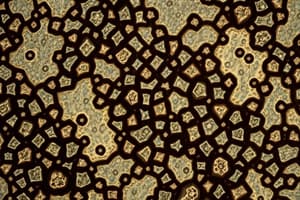Podcast
Questions and Answers
What solution is used when preparing a slide of the onion peel?
What solution is used when preparing a slide of the onion peel?
Safranin solution.
What are unicellular organisms?
What are unicellular organisms?
- Organisms that are microscopic
- Organisms made up of multiple cells
- Organisms that live in colonies
- Organisms consisting of a single cell (correct)
What is the difference between unicellular and multicellular organisms?
What is the difference between unicellular and multicellular organisms?
Unicellular organisms consist of a single cell, while multicellular organisms are made up of many cells that group together to form various body parts.
Flashcards
Cells
Cells
The basic units of living organisms, often microscopic compartments.
Unicellular Organisms
Unicellular Organisms
Living things composed of a single cell, like bacteria or algae.
Multicellular Organisms
Multicellular Organisms
Living things made up of many cells that work together.
Robert Hooke
Robert Hooke
Signup and view all the flashcards
Onion Epidermis
Onion Epidermis
Signup and view all the flashcards
Compound Microscope
Compound Microscope
Signup and view all the flashcards
Microscope Slide
Microscope Slide
Signup and view all the flashcards
Temporary Mount
Temporary Mount
Signup and view all the flashcards
Cover Slip
Cover Slip
Signup and view all the flashcards
Onion Bulb
Onion Bulb
Signup and view all the flashcards
Study Notes
Chapter 5: The Fundamental Unit of Life
- Robert Hooke, in 1665, observed cork cells using a microscope, coining the term "cell".
- Cells are the basic structural and functional units of life.
- Living organisms, from single-celled to multicellular, are composed of cells.
5.1 What are Living Organisms Made Up Of?
- Cells can be observed via onion peel preparation.
- Onion peel epidermis is prepared, placed on a slide, and viewed under a microscope.
- Cells appear similar in shape.
- Cells are the basic units in all living things.
- All organisms are composed of cells.
5.2 What is a Cell Made Up Of?
- Key components of a cell include the plasma membrane, cytoplasm (cell fluid), and nucleus.
- Plasma membrane separates the cell's contents from its surroundings, acting as a selectively permeable barrier.
- Movement of water (osmosis) and other substances across the plasma membrane depends on the concentration gradient.
- Hypotonic solutions (low solute concentration outside the cell) cause water to enter the cell.
- Isotonic solutions (equal solute concentrations inside and outside the cell) result in no net water movement.
- Hypertonic solutions (high solute concentration outside the cell) cause water to leave the cell.
5.2.1 Plasma Membrane
- The outermost membrane separates the cell's contents from the external environment.
- It controls the entry and exit of substances into and out of the cell.
- The plasma membrane is selectively permeable, regulating which substances can pass through.
- Materials move in and out of the cell via osmosis and diffusion.
5.2.2 Cell Wall
- Plant cells have a rigid cell wall composed mostly of cellulose.
- The cell wall provides structural support and protection, preventing cell rupture in hypotonic environments.
- Plasmolysis is cell shrinkage caused by water loss from a plant cell in a hypertonic solution.
5.2.3 Nucleus
- The nucleus is a membrane-bound structure.
- It contains chromosomes with genetic material (DNA).
- Chromosomes have a specific organization and contain genes.
5.2.4 Cytoplasm
- Cytoplasm is the fluid material inside the cell's plasma membrane.
- Within the cytoplasm are various organelles (specialized structures).
- Different cells have different quantities of organelles.
5.2.5 Cell Organelles
- Endoplasmic reticulum (ER): A network of membranes involved in protein and lipid synthesis. It's a transport system in the cell.
- Golgi apparatus: Packages and modifies proteins, and prepares them for transport outside the cell.
- Lysosomes: Contain digestive enzymes. They break down waste materials and cellular debris. They are known as the suicide bags of a cell.
- Mitochondria: The powerhouses of the cell, generating energy (ATP) through cellular respiration.
- Plastids: Found in plant cells, plastids are involved in photosynthesis (chloroplasts) or storage (leucoplasts and chromoplasts).
5.3 Osmosis
- Activity: Observing the effect of osmosis on eggs and raisins.
- Water diffuses from a higher water concentration to a lower water concentration.
- Osmosis is the movement of water across a selectively permeable membrane.
5.4 Cell Division
- Cell division is how new cells are created.
- Mitosis produces two identical daughter cells for growth and repair.
- Meiosis produces four cells with half the number of chromosomes for sexual reproduction.
5.5, 5.6, 5.7
- Includes activities, experiments and questions to test understanding.
Studying That Suits You
Use AI to generate personalized quizzes and flashcards to suit your learning preferences.




